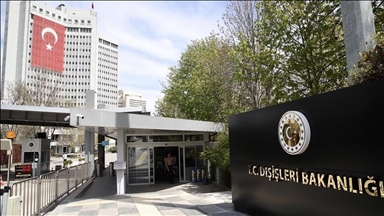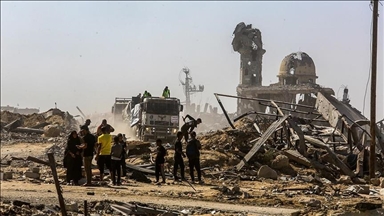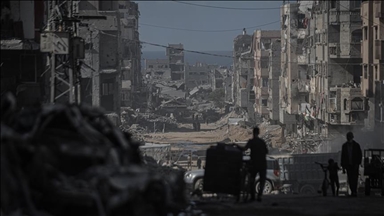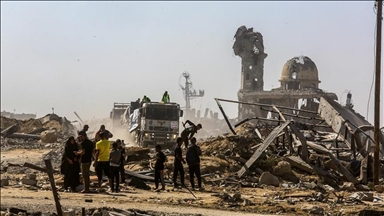Fearing global coverage of atrocities, Israel prepares propaganda-driven media access for journalists entering Gaza
After two years of blocking foreign media, Israel plans to allow journalists into Gaza under tight control to shape coverage and divert attention from its wartime atrocities
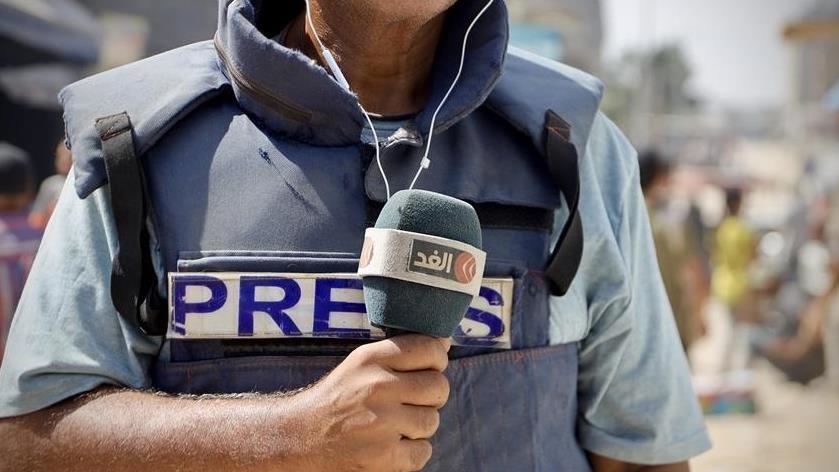 FILE PHOTO
FILE PHOTO
JERUSALEM / ISTANBUL
For two years of genocidal attacks on the Gaza Strip, Israel has barred international journalists from entering the Palestinian enclave in an attempt to obscure atrocities against civilians there.
During that time, the Israeli army organized limited, highly controlled press tours inside Gaza, dictating which photos and videos could be published and prohibiting interviews with Palestinians.
Many journalists refused to join those military-escorted visits, insisting on their right to enter Gaza independently and without restrictions.
With a ceasefire taking effect on Oct. 10 between Israel and Hamas, Tel Aviv now faces a dilemma, as Israel’s Supreme Court reviews a petition filed by the Foreign Press Association demanding permission for independent press entry into Gaza.
To avoid this predicament, Israel is reportedly preparing an “information warfare” campaign to mislead journalists once they are allowed in by designing media scenarios that conceal its atrocities against Palestinians.
Propaganda war
On Sunday, the Israeli daily Yedioth Ahronoth reported that Israel braces for a “propaganda war” as global journalists prepare to enter Gaza.
“Israel is preparing a coordinated media strategy ahead of global journalists’ arrival in Gaza,” the paper said, adding that the plan includes “army-escorted tours and visual evidence” to show what Tel Aviv calls Hamas infrastructure inside civilian areas.
Senior Israeli officials and security agencies have reportedly held “intensive discussions about how to manage Gaza’s imminent reopening to the world.”
“With international forces expected to enter the Strip to assist in locating the hostages and the bodies that Hamas claims are no longer in its possession, Israel is bracing for the arrival of foreign journalists,” the newspaper said.
It noted that reporters “will see the destruction with their own eyes rather than through Hamas-produced footage.”
“The state told the Supreme Court that Israeli and foreign journalists will soon be permitted to enter Gaza under Israeli military escort, up to the boundary known as the ‘yellow line’,” the outlet said.
The “yellow line” refers to the zone to which Israeli forces have withdrawn under the ceasefire agreement, stretching from southern North Gaza Governorate to the outskirts of Rafah.
If global media gain entry, the paper said, officials in Israel’s public diplomacy institutions “will prepare for what they describe as an oncoming wave of negative reports focusing on human stories from Gaza. These stories, they say, will likely feature the suffering of civilians amid the devastation and could reignite criticism of Israel’s conduct during the war.”
Demonstration sites
According to the paper, the Israeli Foreign Ministry and the National Public Diplomacy Directorate are also preparing for Hamas’ expected use of the situation “to advance a propaganda campaign accusing Israel once again of war crimes.”
Facing this dilemma, Yedioth Ahronoth said a strategy session was recently convened by the army spokesperson’s unit with representatives from the Foreign Ministry, the National Public Diplomacy Directorate, and other agencies to deal with the situation.
Participants agreed that “the diplomatic and informational battles are far from over,” it said.
“On the contrary, we expect intensified anti-Israel attacks on social media and in traditional media outlets,” a Foreign Ministry source, speaking anonymously, said.
A senior Israeli official involved in planning the campaign described it as “a central task for every branch of the system.”
He warned that “the challenge is clear and significant, especially because of the widespread destruction visible in Gaza.”
“We are working to prepare explanatory materials, with an emphasis on visual and incriminating evidence,” the official said.
The paper noted that since the ceasefire, criticism of Israel abroad has eased and coverage of the conflict has largely disappeared from front pages.
“Israeli public diplomacy officials now expect that the reopening of Gaza to international reporters will bring the story back into global focus,” it said.
“One idea under review is the establishment of designated sites in Gaza where journalists can be shown how Hamas operated from within civilian areas and hid behind noncombatants.
“Officials say that if the plan is approved, several ‘demonstration sites’ will be created to provide clear visual explanations,” it added.
Difficult stories
Yedioth Ahronoth quoted a senior Israeli source as saying, "It's unclear how much new evidence will be found, because the images have already spread around the world.”
On the potential fallout if journalists enter Gaza, the source said: “This will be the first time that foreign crews enter Gaza, and they will go building by building, presenting difficult stories. We are preparing for every possible scenario.
“They’ll show the ruins and point to Israel as responsible,” he added.
Despite extensive evidence of Israeli crimes, the source insisted that “Israel’s message is unequivocal: Hamas bears the responsibility.”
Ignoring Israel’s violations of international law, the source claimed that blaming Hamas “is consistent with international law.”
Hamas has repeatedly denied using civilian buildings – particularly schools and hospitals – for military purposes, saying Israel’s accusations are merely an attempt to justify its massacres against Palestinians.
Israel has killed more than 68,500 people, mostly women and children, and injured over 170,000 others in deadly attacks in Gaza since October 2023.
Phase one of the Gaza ceasefire deal includes the release of Israeli hostages in exchange for nearly 2,000 Palestinian prisoners. The plan also envisages the rebuilding of Gaza and the establishment of a new governing mechanism without Hamas.
Anadolu Agency website contains only a portion of the news stories offered to subscribers in the AA News Broadcasting System (HAS), and in summarized form. Please contact us for subscription options.



